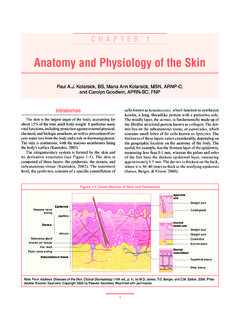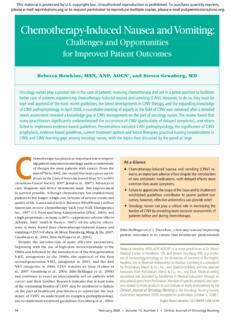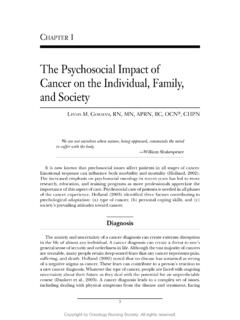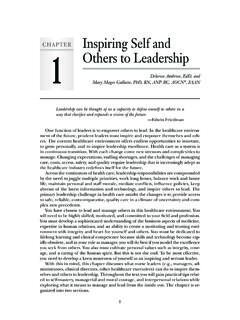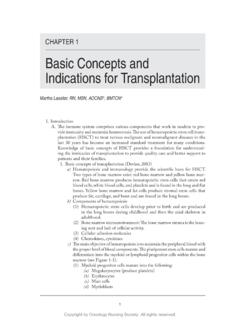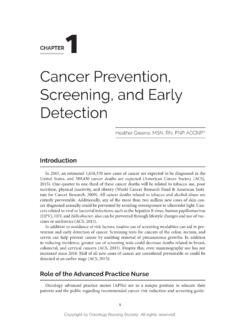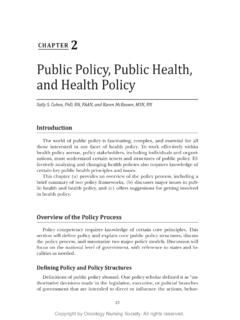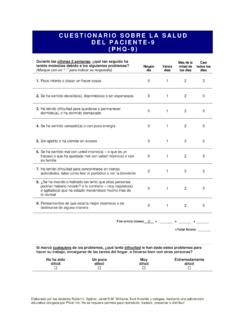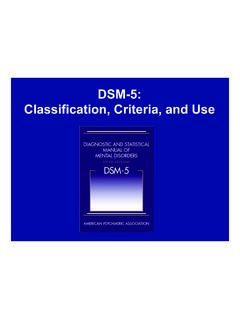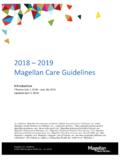Transcription of INSTRUCTION MANUAL Instructions for Patient Health ...
1 PHQ and GAD-7 Instructions P. 1/9 INSTRUCTION MANUAL Instructions for Patient Health Questionnaire (PHQ) and GAD-7 Measures TOPIC PAGES Background 1 Coding and Scoring 2, 4, 5 Versions 3 Use as Severity and Outcome Measures 6-7 Translations 7 Website and Other Issues 8 Selected References 9 BACKGROUND The Primary Care Evaluation of Mental disorders (PRIME-MD) was an instrument developed and validated in the early 1990s to efficiently diagnose five of the most common types of mental disorders presenting in medical populations: depressive, anxiety, somatoform, alcohol, and eating disorders .[1] Patients first completed a one-page 27-item screener and, for those disorders for which they screened positive, were asked additional questions by the clinician using a structured interview guide. However, this 2-stage process took an average of 5-6 minutes of clinician time in patients without a mental disorder diagnosis and 11-12 minutes in patients with a diagnosis.
2 This proved to be a barrier to use given the competing demands in busy clinical practice settings. Therefore, in two large studies enrolling 6000 patients (3000 from general internal medicine and family practice clinics and 3000 from obstetrics-gynecology clinics), a self-administered version of the PRIME-MD called the Patient Health Questionnaire (PHQ) was developed and validated.[2,3] In the past decade, the PHQ in general and the PHQ-9 depression scale in particular [4-6] have gained increasing use in both research and practice. The original PRIME-MD is now largely of historical interest and seldom used except in a few types of research studies. Given the popularity of the PHQ-9 for assessing and monitoring depression severity, a new 7-item anxiety scale using a response set similar to the PHQ-9 was initially developed to diagnose generalized anxiety disorder (hence its name, the GAD-7) and validated in 2740 primary care patients.
3 [7] Though originally developed to diagnose generalized anxiety disorder, the GAD-7 also proved to have good sensitivity and specificity as a screener for panic, social anxiety, and post-traumatic stress disorder.[8] Finally, the PHQ-15 was derived from the original PHQ studies and is increasingly used to assess somatic symptom severity and the potential presence of somatization and somatoform disorders .[9] PHQ and GAD-7 Instructions P. 2/9 Each PHQ module can be used alone ( the PHQ-9 if depression is the condition of interest), together with other modules, or as part of the full PHQ. Also, alternative or abbreviated versions of the PHQ-9 and GAD-7 are sometimes used in certain screening or research settings [10-14] Although the PHQ was originally developed to detect five disorders , the depression, anxiety, and somatoform modules (in that order) have turned out to be the most popular.
4 [10] Also, most primary care patients with depressive or anxiety disorders present with somatic complaints and co-occurrence of somatic, anxiety, and depressive symptoms (the SAD triad) is exceptionally common. This is the rationale behind the PHQ-SADS screener.[15] The most commonly used versions of the PHQ scales are summarized in Table 1, page 3. CODING AND SCORING The full PHQ, Brief PHQ, and PHQ for Adolescents (PHQ-A) can be used to establish provisional diagnoses for selected DSM-IV disorders . The diagnostic algorithm for the PHQ modules are included in footers at the bottom of each page of the PHQ, and also reiterated in Table 2, page 4. The other measures are principally used to derive severity scores (PHQ-9 and PHQ-8 for depressive symptom severity; GAD-7 for anxiety symptom severity; PHQ-15 for somatic symptom severity) or as ultra-brief screeners (PHQ-2, GAD-2, PHQ-4). An example in which the PHQ depression module can be used as both a diagnostic module as well as a depression severity score (PHQ-9 score) is shown in Table 3, page 5.
5 Over time, the severity scores have been a particularly popular use of the measures, and are now used much more commonly than the provisional diagnoses. For example, cutpoints of 5, 10, and 15 represent mild, moderate, and severe levels of depressive, anxiety, and somatic symptoms, on the PHQ-9, GAD-7, and PHQ-15 respectively. Also, a cutpoint of 10 or greater is considered a yellow flag on all 3 measures ( , drawing attention to a possible clinically significant condition), while a cutpoint of 15 is a red flag on all 3 measures ( , targeting individuals in whom active treatment is probably warranted). For the ultra-brief measures (PHQ-2 and GAD-2), a score of 3 or greater should prompt administration of the full PHQ-9 and/or GAD-7, as well as a clinical interview to determine whether a mental disorder is present. The final question on the PHQ (and some of its abbreviated versions) asks the patients to report how difficult have these problems made it for you to do your work, take care of things at home, or get along with other people?
6 This single Patient -rated difficulty item is not used in calculating any PHQ score or diagnosis but rather represents the Patient s global impression of symptom-related impairment. It may be useful in decisions regarding initiation of or adjustments to treatment since it is strongly associated with both psychiatric symptom severity as well as multiple measures of impairment and Health -related quality of life. A particularly important question is how to assess suicide risk in individuals who answer positively to the 9th question of the PHQ-9. A four-item screener has been developed that may assist in positive responses to this 9th question [16], although a final decision about the actual risk of self-harm requires a clinical interview. PHQ and GAD-7 Instructions P. 3/9 Table 1. Versions: Patient Health Questionnaire (PHQ) Family of Measures Measure Description Scoring References Core PRIME-MD Predecessor of PHQ, now mainly of historical interest.
7 Combined self-administered Patient screener with clinician follow-up questions. 1 PHQ Five modules covering 5 common types of mental disorders : depression, anxiety, somatoform, alcohol, and eating . Selected (but provisional) DSM-IV diagnoses for all types of disorders except somatoform. 2, 3 PHQ-9 Depression scale from PHQ. Nine items, each of which is scored 0 to 3, providing a 0 to 27 severity score. 1, 4, 5, 6, 10 GAD-7 Anxiety measure developed after PHQ but incorporated into PHQ-SADS. Seven items, each of which is scored 0 to 3, providing a 0 to 21 severity score. 7, 8, 10 PHQ-15 Somatic symptom scale from PHQ. Fifteen items, each of which is scored 0 to 2, providing a 0 to 30 severity score. 9, 10 PHQ-SADS PHQ-9, GAD-7, and PHQ-15 measures, plus panic measure from original PHQ. See scoring for these scales above. 10 Variants Brief PHQ PHQ-9 and panic measures from original PHQ plus items on stressors and women s Health . See scoring for PHQ above.
8 Stressor and women s Health items are not diagnostic or scored. 3 PHQ-A Substantially modified version of PHQ developed for use in adolescents. Moderate data exists for validity but much less than for original PHQ. Diagnostic scoring described in MANUAL , available upon request. 11 PHQ-2 First 2 items of PHQ-9. Ultra-brief depression screener. Two items scored 0 to 3 (total score of 0-6) 10, 12 GAD-2 First 2 items of GAD-7. Ultra-brief anxiety screener. Two items scored 0 to 3 (total score of 0-6) 8, 10, 12 PHQ-4 PHQ-2 and GAD-2. See PHQ-2 and GAD-2 above. 10, 12, 13 PHQ-8 All items of PHQ-9 except the 9th item on self-harm. Mainly used in non-depression research studies. Eight items, each of which is scored 0 to 3, providing a 0 to 24 severity score. 5, 10, 14 PHQ and GAD-7 Instructions P. 4/9 Table 2. Diagnostic Algorithms for the PHQ Page 1 Somatoform Disorder if at least 3 of #1a-m bother the Patient a lot and lack an adequate biological explanation.
9 Major Depressive Syndrome if #2a or b and five or more of #2a-i are at least More than half the days (count #2i if present at all) . Other Depressive Syndrome if #2a or b and two, three, or four of #2a-i are at least More than half the days (count #2i if present at all). Note: the diagnoses of Major Depressive Disorder and Other Depressive Disorder requires ruling out normal bereavement (mild symptoms, duration less than 2 months), a history of a manic episode (Bipolar Disorder) and a physical disorder, medication or other drug as the biological cause of the depressive symptoms. Page 2 Panic Syndrome if #3a-d are all YES and 4 or more of #4a-k are YES . Other Anxiety Syndrome if #5a and answers to three or more of #5b-g are More than half the days . Note: The diagnoses of Panic Disorder and Other Anxiety Disorder require ruling out a physical disorder, medication or other drug as the biological cause of the anxiety symptoms.
10 Page 3 Bulimia Nervosa if #6a,b, and c and #8 are YES ; Binge eating Disorder the same but #8 is either NO or left blank. Alcohol abuse if any of #10a-e are YES . Additional Clinical Considerations. After making a provisional diagnosis with the PHQ, there are additional clinical considerations that may affect decisions about management and treatment. Have current symptoms been triggered by psychosocial stressor(s)? What is the duration of the current disturbance and has the Patient received any treatment for it? To what extent are the Patient s symptoms impairing his or her usual work and activities? Is there a history of similar episodes, and were they treated? Is there a family history of similar conditions? PHQ and GAD-7 Instructions P. 5/9 Table 3. Example of PHQ Depression Module for both Diagnostic and Severity Purposes Patient : A 43-year-old woman who looks sad and complains of fatigue for the past month. 2. Over the last 2 weeks, how often have you been bothered byany of the following:Not at all Several days More than half the days Nearly every day (0) (1) (2) (3) interest or pleasure in doing things?
